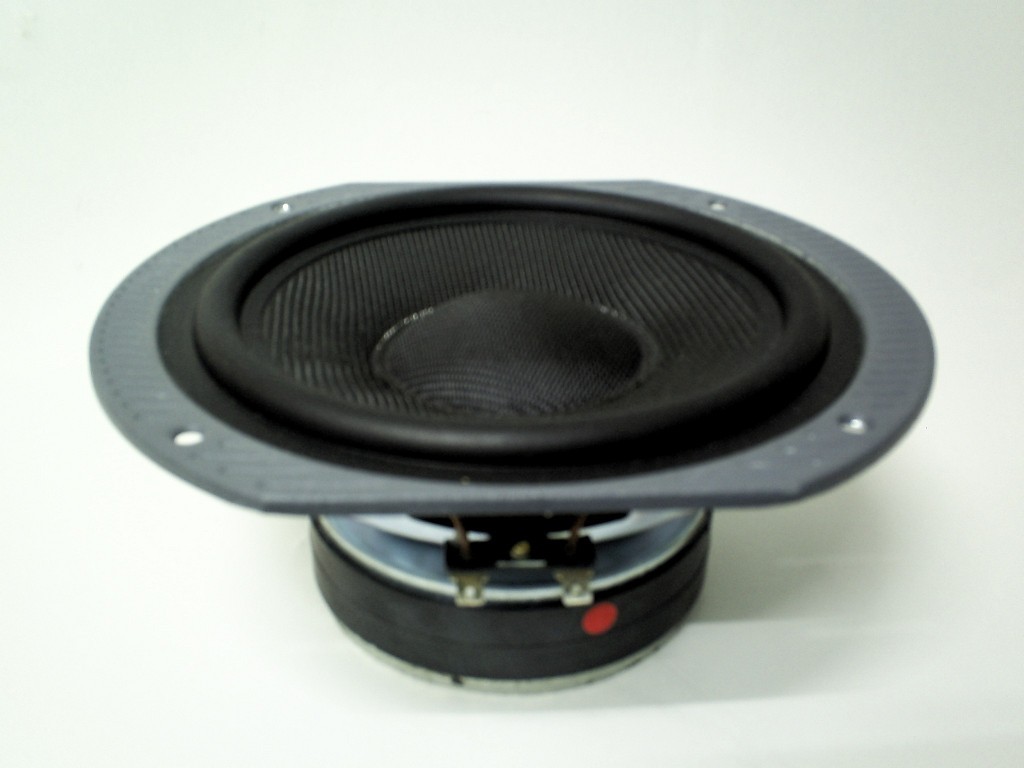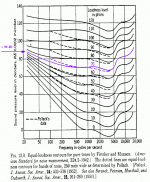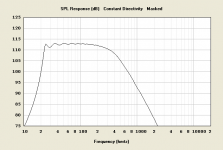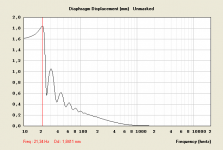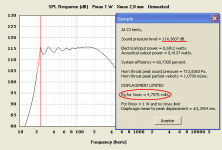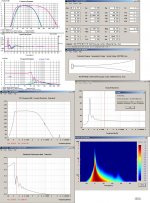Hi amjulio,
You have assumed that the acoustical output power is increased by a constant K watts, independent of frequency. Because the load is a complex impedance (it has resistive and reactive components that both change with frequency) the acoustical output power varies considerably with frequency - even though the electrical input power is a constant 1 watt (in your example).
For the normal constant voltage SPL response, the acoustical output power also varies with frequency - but by a different amount to that obtained when the Maximum SPL tool is used.
This is why the ripple amplitude changes.
It was intended to support my earlier comments in the post, yes.
The Maximum SPL tool shows the overall performance envelope of the loudspeaker when limited by either the driver rated thermal input power Pmax or the diaphragm linear mean-to-peak displacement Xmax. You are correct in thinking that the standard constant voltage SPL response provides a more realistic prediction of how the loudspeaker will perform in practice under normal conditions.
Kind regards,
David
ripple shouldn´t increase when output power is increased
You have assumed that the acoustical output power is increased by a constant K watts, independent of frequency. Because the load is a complex impedance (it has resistive and reactive components that both change with frequency) the acoustical output power varies considerably with frequency - even though the electrical input power is a constant 1 watt (in your example).
For the normal constant voltage SPL response, the acoustical output power also varies with frequency - but by a different amount to that obtained when the Maximum SPL tool is used.
This is why the ripple amplitude changes.
I wonder if your last remark explain ripple increment.
It was intended to support my earlier comments in the post, yes.
What is SPL Maximun for?. Because normal power amplifiers have constant voltage outputs. So the normal output of Hornresp models better reality I think. Am I wrong?
The Maximum SPL tool shows the overall performance envelope of the loudspeaker when limited by either the driver rated thermal input power Pmax or the diaphragm linear mean-to-peak displacement Xmax. You are correct in thinking that the standard constant voltage SPL response provides a more realistic prediction of how the loudspeaker will perform in practice under normal conditions.
Kind regards,
David
Thanks Dave.
It's clear now for me: costant electrical power on variable (with frequency) efficiency implies variable SPL. Makes sense.
I think I have finished the design of the underground horn for my new house
It's clear now for me: costant electrical power on variable (with frequency) efficiency implies variable SPL. Makes sense.
I think I have finished the design of the underground horn for my new house
I think I have finished the design of the underground horn for my new house
Hi amjulio,
It's magnífico
Kind regards,
David
Hi amjulio,
It's magnífico.
Kind regards,
David
18.000cm2 horn will "emerge" in a corner through a 1,8m2 wire mesh triangle

iron mesh
the triangle in the corner will be covered with this mesh.
18.000cm2 horn will "emerge" in a corner through a 1,8m2 wire mesh triangle
I got decent results with ML-8P150 MID-BASS8"PROFESIONAL (Bl = 13,58 Tm) and also with
iron mesh
the triangle in the corner will be covered with this mesh.
It doesn't matter if you use a front loaded horn, a back loaded horn, a bandpass subwoofer, a sealed box, a vented box or a tapped horn:
At low frequency, maximum output is limited by displacement.
That's why I'd strongly discourage you from building such a complex enclosure for an 8" woofer. You'll be severely limited by displacement.
I'm using a pair of twelves in a 350lb tapped horn, and it's working pretty well. At these output levels the enclosure stiffness becomes a big factor.
Unless, of course, the horn is adequately sized to act as an acoustic transformer, in which case power may become the limit instead.At low frequency, maximum output is limited by displacement.
Unless, of course, the horn is adequately sized to act as an acoustic transformer, in which case power may become the limit instead.
amjulio's woofer has 3mm of xmax :
B-6K | GB-AUDIO

IMHO, investing the time and expense in building such an elaborate horn will yield substandard results. Horn's can't work miracles. To make bass, you need displacement. 3mm won't cut it.
IMHO, investing the time and expense in building such an elaborate horn will yield substandard results. Horn's can't work miracles. To make bass, you need displacement. 3mm won't cut it.
Patrick: by substandard results, do you mean because of the elaborate horn, or because of the driver?
amjulio: I would say that if you put that much work into building a horn subwoofer, you really owe yourself to drive it with a high quality woofer that can provide enough volume displacement. 3mm can work if the diaphragm area is large enough, but an 8" driver is too small for subwoofer use, even with a horn.
I have built horn subwoofer using single 10", 15" and double 12". Use 15" or (double) 12", 10" is too small. Maybe one of the long-throw woofers could work, but I would rather go for smaller displacement and larger area.
Regards,
Bjørn
area needed
I agree: we need to move volume to get the SPL we want. The lower frecuency we want our SPL the more volumen we have to move.
I made my math.
An educated guess (see below) tells me I'd got divorce if I pretend more than 70 fon in my house. 70 fon at 25 Hz implies SPL < 90 dB (see fons.gif).
if I pretend more than 70 fon in my house. 70 fon at 25 Hz implies SPL < 90 dB (see fons.gif).
I'm getting more than 110 dB (SPL.png) with Xmax = 1,84 mm (diplacement.png)
Simulating with option SPL maximun @ P=1W =constant frecuency limit is 23Hz (see displacement @ SPL Maximum.png). Go beyond driver limits implies to feed Eg = 4,7575 V to get 114 dB of SPL, but 114 dB of SPL is close to the pain limit!!!.
So, it seems design is more robust than my ear and 54 dB more resistant than my marital status
I agree: we need to move volume to get the SPL we want. The lower frecuency we want our SPL the more volumen we have to move.
I made my math.
An educated guess (see below) tells me I'd got divorce
I'm getting more than 110 dB (SPL.png) with Xmax = 1,84 mm (diplacement.png)
Simulating with option SPL maximun @ P=1W =constant frecuency limit is 23Hz (see displacement @ SPL Maximum.png). Go beyond driver limits implies to feed Eg = 4,7575 V to get 114 dB of SPL, but 114 dB of SPL is close to the pain limit!!!.
So, it seems design is more robust than my ear and 54 dB more resistant than my marital status
An educated guess on complaints.
From Beranek, Acustics, Fig 13.22 I adopt noise rating D (mild complaints) to E (strong compliants).
From Fig. 13.23 we see maximun SPL @ 20-75 Hz band for D rating is 74 dB and for E is SPL = 77 dB i.e. 50..60 fon. I adopt loudeness = 70 fon
From Beranek, Acustics, Fig 13.22 I adopt noise rating D (mild complaints) to E (strong compliants).
From Fig. 13.23 we see maximun SPL @ 20-75 Hz band for D rating is 74 dB and for E is SPL = 77 dB i.e. 50..60 fon. I adopt loudeness = 70 fon
Attachments
Note that at 100 to 110dB that the phon to spl are nearly equal and nearly constant over the whole audio range from 20Hz to 1000Hz.
If you can achieve a peak 110dB SPL target, then that same target applies to all frequencies <=1kHz.
That 110dB target would allow average listening levels of 80dB to 100dB depending on music type and not clip any signals <110dB
For most well recorded music an average level of 90dB is very loud.
I often listen at average levels around 70dB.
If you can achieve a peak 110dB SPL target, then that same target applies to all frequencies <=1kHz.
That 110dB target would allow average listening levels of 80dB to 100dB depending on music type and not clip any signals <110dB
For most well recorded music an average level of 90dB is very loud.
I often listen at average levels around 70dB.
Last edited:
..I made my math...
Hi amjulio,
You certainly did it!
Here's a picture in order to explore your design: I think using adequate (max rec. BW) filters and a ~20 mS signal-delay line is necessary to make your design peak in performance:
b
Attachments
Hi amjulio,
You certainly did it!
Here's a picture in order to explore your design: I think using adequate (max rec. BW) filters and a ~20 mS signal-delay line is necessary to make your design peak in performance:
b
Hi, Bjorno
Yes about BP filters. What did you mean with "max rec."?.
I'm absolutely ignorant about delay issue, do you mean I'd lag bass channel 20 ms respect to medium and high frecuency bands?.
Spectrogram: thinking about what information spectrogram gives us my conclusion was: acustic energy at 100Hz decays 25dB 20ms after electrical power input stops. Higher frecuencies damp much before and lower ones doesn´t matter because our ear is not so sensitive. On the other hand I believe my room will have a reberveration time larger, so horn reverberation time wouldn't be an issue.
What do you think?. I have not experience in audio so your warnings and feedbacks are welcome.
Last edited:
Patrick: by substandard results, do you mean because of the elaborate horn, or because of the driver?
amjulio: I would say that if you put that much work into building a horn subwoofer, you really owe yourself to drive it with a high quality woofer that can provide enough volume displacement. 3mm can work if the diaphragm area is large enough, but an 8" driver is too small for subwoofer use, even with a horn.
I have built horn subwoofer using single 10", 15" and double 12". Use 15" or (double) 12", 10" is too small. Maybe one of the long-throw woofers could work, but I would rather go for smaller displacement and larger area.
Regards,
Bjørn
Exactly what you said - if you're going to go to all that trouble, use a woofer with some displacement.
Exactly what you said - if you're going to go to all that trouble, use a woofer with some displacement.
Well... personally not too much trouble, actually I have a couple of masons building my house, my work is not to much and lot of fun reading and simulating with Hornresp.
Patrick, Why should I get a better (more displacement) imported driver if the one I can get not too far from my home gives more acustic power than I need?
Hi, Bjorno
Yes about BP filters. What did you mean with "max rec."?.
I'm absolutely ignorant about delay issue, do you mean I'd lag bass channel 20 ms respect to medium and high frecuency bands?.
Spectrogram: thinking about what information spectrogram gives us my conclusion was: acustic energy at 100Hz decays 25dB 20ms after electrical power input stops. Higher frecuencies damp much before and lower ones doesn´t matter because our ear is not so sensitive. On the other hand I believe my room will have a reberveration time larger, so horn reverberation time wouldn't be an issue.
What do you think?. I have not experience in audio so your warnings and feedbacks are welcome.
Hi amjulio,
First: When your numbers are put into HR it returns a promising sub with good possible performance and that is IMO admirable 'per se'.
With max rec. BW I meant you should restrict the lower FR boundary to ~30 Hz for either of the suggested drivers, possibly even moved a bit lower, for what it's worth, that only if using the recommended Bw4 HPF.
In my simulation: For the upper FR boundary I recommend not to XO higher than 145 Hz for possible localization issues that surely will appear if passed and if using a LR2 filter at 80 Hz would be safe too.
250 Hz is then – 20 dB down when a LR4 or a LR2 filter is used. It is possible to XO as high as 180 Hz if using a brick-wall filter LP slope but then the sub should be centered between the Main Speakers but I do not recommend this approach.
The excess group delay for you sub-horn is ~20 mS that has to be taken into consideration if you want a smooth XO integration with your mains. The cure here is to signal delay your Mains correspondingly otherwise you will hear bass/mid-bass not in sync with the higher registers.
As I can see there are no issues when looking at the wavelet spectrogram, it's almost flawless or a textbook case for a perfect IR.
You're right your room IR (best illustrated in a ETC graph) should dominate by totally masking the sub's IR and adding more than10 times of room amplitude response decay. No worries here..
Concerning the sub-horn dB SPL capability, I find your design capable enough with an IMO healthy SPL margin I wouldn't exceed for esthetically reasons, especially if listening to the kind of ' acoustic' music i prefer.
Movie sound (Ka-boooom!!!) do not impress me at all, often not proportional to the visual content but instead very exaggerated
b
agreement & aspect ratio
Aspect Ratio
Doy you think aspect ratio of the horn not square could cause some trouble?. Please, answer here: http://www.diyaudio.com/forums/subwoofers/203449-horn-hom-aspect-ratio.html#post2839927
I strongly AGREE. Exaggeration is The Word for home teathre sound system.
Aspect Ratio
Doy you think aspect ratio of the horn not square could cause some trouble?. Please, answer here: http://www.diyaudio.com/forums/subwoofers/203449-horn-hom-aspect-ratio.html#post2839927
Hi amjulio,
Movie sound (Ka-boooom!!!) do not impress me at all, often not proportional to the visual content but instead very exaggeratedjust to impress people not grown up enough or addressed to faint hearted .. like teens who almost wet their pants for a sudden unreal designed sound.
b
I strongly AGREE. Exaggeration is The Word for home teathre sound system.
how to simulate two ou more box in HR when it' s done for one ?
Hi blo06,
Either select Tools > Multiple Speakers or press Ctrl+K from the SPL Response window.
Kind regards,
David
Hi David,
does Multiple Speakers give the output for 2 speakers in the same box or 2 similar boxes with one speaker ?
Or is it the same ?
What I'm looking for is the response for 2 similar boxes with one speaker.
Cheers.
Hi blo06,
The Multiple Speakers tool will enable you to find the response for two similar boxes, each with one driver. Please note that there is currently some question as to the accuracy of the Hornresp multiple speaker predictions at higher frequencies.
http://www.diyaudio.com/forums/subwoofers/170771-single-sheet-th-challenge-127.html#post2848882
The Driver Arrangement tool (accessible from the input parameters screen when in Edit mode) will enable you to find the response for one box with two drivers.
Kind regards,
David
Last edited:
- Home
- Loudspeakers
- Subwoofers
- Hornresp
